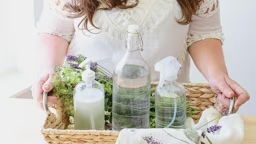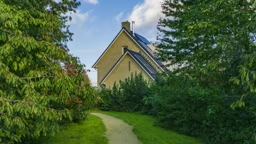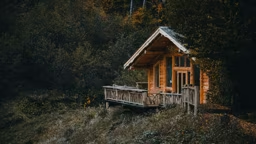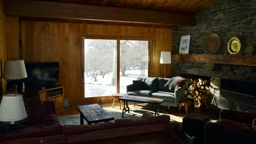1 Blend. Native plantings create yards that blend into natural surroundings, rather than stand out with Eurasian-born transplants.
2 Plant for the future. Be proud of America’s history. Plant the flora that was here before our immigrant ancestors arrived; it’s the plant life with built-in hardiness, so it will sustain for future generations.
3 Relax. When matched with your site conditions, native plants need little to no watering, weeding and fertilizers. Unlike groomed lawns, native landscaping doesn’t need weekly maintenance. Get off the lawn mower and enjoy your weekend on the deck, in the boat or in the hammock!
4 Attract butterflies. Native plants attract native butterflies! Many caterpillars feed exclusively on one type of plant before transforming into their beautiful adult form. Plant milkweeds to attract monarchs.
5 Attract birds. Go beyond bird feeders; create a native-plant feeding station that doubles as habitat. Plant a few cup plants (Silphium perfoliatum), and watch goldfinches and indigo buntings eat the ripened seeds during late-summer days.
2 Plant for the future. Be proud of America’s history. Plant the flora that was here before our immigrant ancestors arrived; it’s the plant life with built-in hardiness, so it will sustain for future generations.
3 Relax. When matched with your site conditions, native plants need little to no watering, weeding and fertilizers. Unlike groomed lawns, native landscaping doesn’t need weekly maintenance. Get off the lawn mower and enjoy your weekend on the deck, in the boat or in the hammock!
4 Attract butterflies. Native plants attract native butterflies! Many caterpillars feed exclusively on one type of plant before transforming into their beautiful adult form. Plant milkweeds to attract monarchs.
5 Attract birds. Go beyond bird feeders; create a native-plant feeding station that doubles as habitat. Plant a few cup plants (Silphium perfoliatum), and watch goldfinches and indigo buntings eat the ripened seeds during late-summer days.
6 Stabilize delicate slopes and shorelines. Native plants in their home territory typically send down deeper roots than non-natives and shallow-rooted lawn grasses. So the native plants collect and filter more storm-water runoff than shallow-rooted lawn grasses, stabilizing slopes and shorelines while keeping your lake cleaner.
7 Battle skeeters naturally. If you hate mosquitoes, plant native plants! Dragonflies and other invertebrate predators will flock to your yard like a brigade in search of their evening meal. They won’t entirely eliminate your mosquito problem, but any step is a positive one when it comes to battling those pesky skeeters!
8 Beautify. Choose from thousands of wildflowers, grasses, shrubs and trees to add bright colors, textures, and native beauty to your landscape. For example, picture a pagoda dogwood grove among a sea of wild ginger (both are native to the eastern half of the U.S.).
9 Plant for success. Native plants are superior ground covers where typical lawn turf fails. If your lawn isn’t thriving, seek a native alternative. For dry, acidic, sandy soils, plant wild blueberries.
10 Do it for the ducks. Waterfowl, such as blue-winged teal, which are common throughout the U.S., need shelter to escape their predators. So instead of mowing down or removing native wetland plants from your shoreline or nearby shallow waters, let the plants grow wild into a buffer between your yard and recreational lake space to provide protective cover for waterfowl from raccoons, opossum and skunks.
If you want to add plantings to your shoreline buffer, your local extension office can help you select native plant types. Possibilities might include joe-
pye weed, fox sedge and alder.
11 Do it for the frogs and fish too. Frogs and fish also benefit from buffers along the shore. According to the Wisconsin Department of Natural Resources, green frogs are an excellent indicator of healthy near-shore habitat, as male green frogs establish breeding territories within 2 feet of a lake’s edge. If you allow a natural shoreline to prosper, fish like bluegill and bass will benefit from the shelter and shade – not to mention the insect (and yes, frog) meals.
So, go native and discover the alternative to groomed lawns, sculpted junipers, leaf-blowing and chemical weed-killers. You can make your cabin look like it was just magically lowered from the sky onto your beautiful land, as if it had always been there.
For her day job, Jennifer Baker is the senior ecologist, designer and consultant for Prairie Nursery. See more of Jennifer’s work at www.prairienursery.com.
7 Battle skeeters naturally. If you hate mosquitoes, plant native plants! Dragonflies and other invertebrate predators will flock to your yard like a brigade in search of their evening meal. They won’t entirely eliminate your mosquito problem, but any step is a positive one when it comes to battling those pesky skeeters!
8 Beautify. Choose from thousands of wildflowers, grasses, shrubs and trees to add bright colors, textures, and native beauty to your landscape. For example, picture a pagoda dogwood grove among a sea of wild ginger (both are native to the eastern half of the U.S.).
9 Plant for success. Native plants are superior ground covers where typical lawn turf fails. If your lawn isn’t thriving, seek a native alternative. For dry, acidic, sandy soils, plant wild blueberries.
10 Do it for the ducks. Waterfowl, such as blue-winged teal, which are common throughout the U.S., need shelter to escape their predators. So instead of mowing down or removing native wetland plants from your shoreline or nearby shallow waters, let the plants grow wild into a buffer between your yard and recreational lake space to provide protective cover for waterfowl from raccoons, opossum and skunks.
If you want to add plantings to your shoreline buffer, your local extension office can help you select native plant types. Possibilities might include joe-
pye weed, fox sedge and alder.
11 Do it for the frogs and fish too. Frogs and fish also benefit from buffers along the shore. According to the Wisconsin Department of Natural Resources, green frogs are an excellent indicator of healthy near-shore habitat, as male green frogs establish breeding territories within 2 feet of a lake’s edge. If you allow a natural shoreline to prosper, fish like bluegill and bass will benefit from the shelter and shade – not to mention the insect (and yes, frog) meals.
So, go native and discover the alternative to groomed lawns, sculpted junipers, leaf-blowing and chemical weed-killers. You can make your cabin look like it was just magically lowered from the sky onto your beautiful land, as if it had always been there.
For her day job, Jennifer Baker is the senior ecologist, designer and consultant for Prairie Nursery. See more of Jennifer’s work at www.prairienursery.com.
I work for a landscape business that has many cabin-owning clients. I received a call from a customer who recently purchased a beautiful wooded lot on the shores of a northern Wisconsin lake. He was panicked.
He feared he had demolished the wild feel of his future retreat during basement excavation. The natural habitat was his primary reason for purchasing the lot, and he desperately wanted it back.
Unaware of native alternatives, he was ready to throw down a bag of Kentucky bluegrass lawn seed onto the bare ground.
That’s not unusual. We often turn to familiar landscaping choices, such as bluegrass lawns, to heal our cabins into their wild surroundings. But the final result is a yard that reflects the suburban landscape ideal, not the essence of a more primitive cabin refuge.
So I suggested to my client that instead of seeding a lawn, we could easily restore the natural beauty of his property by letting nature regenerate itself and by adding some plants native to northern Wisconsin.
Native landscaping, often synonymous with natural landscaping, continues to gain popularity with cabin owners who seek an environment that is indigenous and sustainable.
So here are 11 reasons to go native and natural in your cabin yard:
He feared he had demolished the wild feel of his future retreat during basement excavation. The natural habitat was his primary reason for purchasing the lot, and he desperately wanted it back.
Unaware of native alternatives, he was ready to throw down a bag of Kentucky bluegrass lawn seed onto the bare ground.
That’s not unusual. We often turn to familiar landscaping choices, such as bluegrass lawns, to heal our cabins into their wild surroundings. But the final result is a yard that reflects the suburban landscape ideal, not the essence of a more primitive cabin refuge.
So I suggested to my client that instead of seeding a lawn, we could easily restore the natural beauty of his property by letting nature regenerate itself and by adding some plants native to northern Wisconsin.
Native landscaping, often synonymous with natural landscaping, continues to gain popularity with cabin owners who seek an environment that is indigenous and sustainable.
So here are 11 reasons to go native and natural in your cabin yard:















